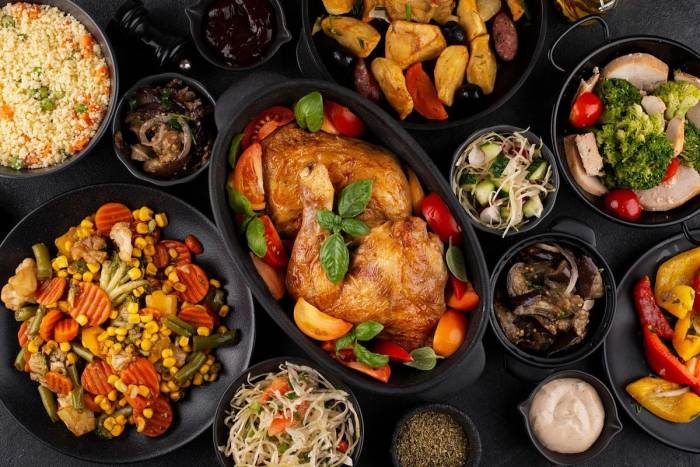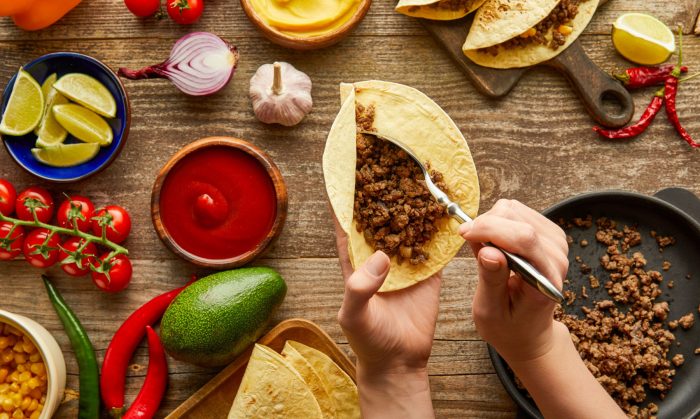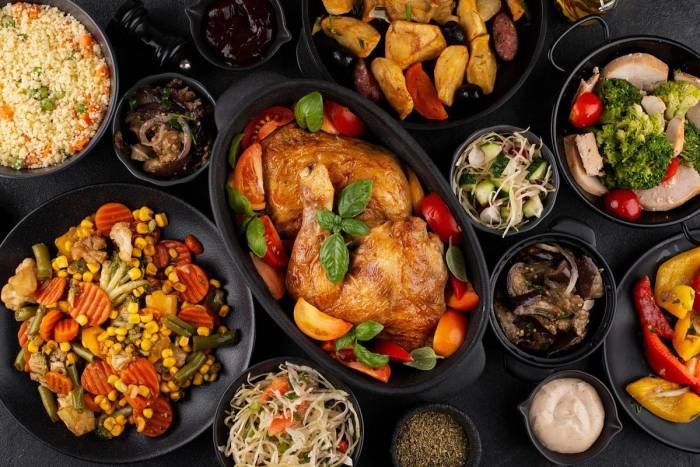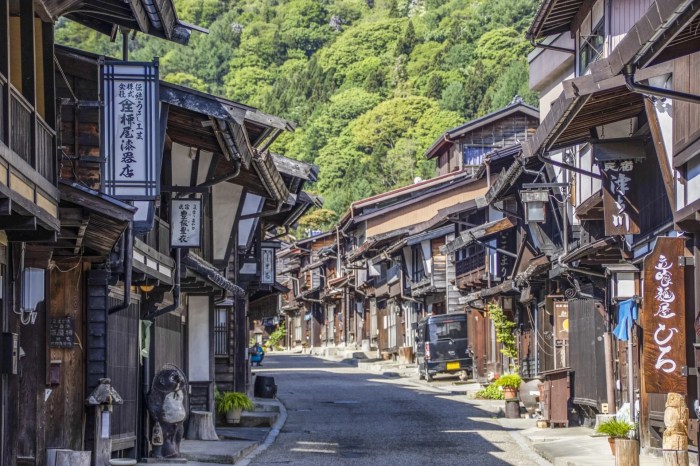Nanjing dishes Chinese cuisine unveils a captivating world of flavors and traditions. From ancient roots to modern interpretations, this exploration dives deep into the heart of Nanjing’s culinary heritage, revealing the distinct characteristics that set its cuisine apart. We’ll uncover the prominent ingredients and cooking methods, explore iconic dishes, and discover how regional variations shape the unique tastes of this fascinating region.
This journey will trace the history of Nanjing cuisine, highlighting its evolution from ancient times to the present day. We’ll explore the stories behind famous dishes, and examine the unique cooking methods that define this regional style. The insights offered will encompass the cultural significance of food in Nanjing society, and explore the modern interpretations of these time-honored recipes.
Introduction to Nanjing Cuisine
Nanjing cuisine, a significant branch of Chinese culinary traditions, boasts a rich history deeply intertwined with the city’s vibrant past. From its role as a capital city throughout various dynasties to its strategic location along major waterways, Nanjing’s cuisine absorbed influences from neighboring regions, developing a unique identity that distinguishes it from other styles. This distinct flavor profile reflects the city’s cultural heritage and its position as a crucial crossroads of trade and exchange.Nanjing cuisine, while sharing commonalities with other Jiangsu-style dishes, stands apart through its emphasis on fresh, high-quality ingredients and meticulous preparation methods.
The cuisine is known for its delicate balance of flavors, often showcasing a harmonious blend of savory, sweet, and sour notes. This culinary tradition is a testament to Nanjing’s history and the region’s commitment to culinary excellence.
Key Characteristics of Nanjing Cuisine
Nanjing cuisine is characterized by its delicate balance of flavors, a hallmark of Jiangsu-style cooking. It often showcases a harmonious blend of savory, sweet, and sour tastes, achieved through careful selection of ingredients and precise cooking techniques. The cuisine also emphasizes the use of fresh, high-quality ingredients, reflecting the region’s agricultural bounty and commitment to culinary excellence.
Ingredients and Cooking Methods
Nanjing cuisine frequently utilizes a variety of fresh vegetables, including seasonal greens, mushrooms, and root vegetables. Seafood, especially river fish, is also a staple, reflecting the region’s proximity to waterways. Pork and chicken are common protein sources, often prepared in ways that highlight their natural flavors. The cooking methods used in Nanjing cuisine are diverse, encompassing stir-frying, braising, and steaming, with each method chosen to complement the specific ingredients and desired outcome.
The meticulous preparation and careful selection of ingredients are crucial to achieving the balanced and nuanced flavors characteristic of Nanjing cuisine.
Examples of Nanjing Dishes
| Dish Name | Description | Key Ingredients | Region of Origin |
|---|---|---|---|
| Yangzhou Fried Rice | A fragrant and flavorful fried rice dish, often featuring various vegetables, meats, and a savory sauce. | Rice, vegetables (e.g., carrots, peas), meats (e.g., pork, shrimp), soy sauce, oil | Yangzhou, Jiangsu Province (close to Nanjing) |
| Nanjing Braised Pork | Tender pork, braised in a rich sauce with a balance of sweet, sour, and savory flavors. | Pork belly, soy sauce, sugar, vinegar, ginger, garlic | Nanjing, Jiangsu Province |
| Nanjing Fried Noodles | A dish of stir-fried noodles with vegetables and meat, showcasing a distinct Nanjing flavor profile. | Noodles, vegetables, meat (e.g., beef, pork), soy sauce, sesame oil | Nanjing, Jiangsu Province |
| Nanjing Steamed Fish | A delicate dish of steamed fish with a light sauce, highlighting the natural flavors of the fish. | Fresh fish, ginger, scallions, soy sauce | Nanjing, Jiangsu Province |
Famous Nanjing Dishes
Nanjing cuisine, renowned for its delicate flavors and diverse ingredients, boasts a rich tapestry of iconic dishes. From savory stews to delicate dumplings, each dish tells a story of the city’s culinary heritage. This exploration delves into five of Nanjing’s most celebrated culinary creations, highlighting their preparation methods and unique taste profiles.
Signature Nanjing Dishes
Nanjing cuisine offers a delightful blend of flavors, incorporating fresh vegetables, savory meats, and aromatic spices. The dishes are often characterized by their use of high-quality ingredients and meticulous preparation techniques. The culinary traditions of Nanjing have been passed down through generations, resulting in a distinct culinary identity that reflects the city’s history and culture.
Braised Pork with Bamboo Shoots (红烧肉)
This dish showcases Nanjing’s masterful use of braising techniques. Tender pork belly is simmered in a rich sauce, often incorporating fermented soybeans, sugar, and spices. The resulting pork is incredibly succulent and flavorful, perfectly complementing the delicate sweetness of the bamboo shoots. The slow cooking process allows the flavors to meld, resulting in a harmonious blend of textures and tastes.
The key to a truly authentic braised pork is in the slow simmering, ensuring the meat remains moist and the sauce develops a complex depth of flavor.
Nanjing Fried Rice (南京炒饭)
This dish is a testament to the versatility of Nanjing cuisine, using leftover rice and other ingredients to create a flavorful and satisfying meal. The rice is stir-fried with a blend of vegetables, meats, and savory seasonings. The addition of preserved vegetables and soy sauce adds a distinct layer of umami to the dish. This method of repurposing leftover ingredients is a hallmark of Nanjing cuisine, promoting efficiency and resourcefulness in the kitchen.
Nanjing Steamed Dumplings (南京蒸饺)
These delicate dumplings are a quintessential example of Nanjing’s culinary artistry. The dumplings are typically filled with a savory mixture of pork, vegetables, and spices. The delicate dough, carefully formed into small wrappers, is steamed to perfection, resulting in a soft, airy texture. The filling’s savory notes and the soft texture of the dough make it a truly satisfying and comforting dish.
The key is the precise handling of the dough and the balance of flavors in the filling.
Fish in Ginger Sauce (姜汁鱼), Nanjing dishes chinese cuisine
This dish demonstrates the skillful use of fresh ginger in Nanjing cuisine. The fish, often carp or other freshwater fish, is meticulously prepared with a ginger-based sauce. The bright flavors of ginger are balanced with other spices, creating a unique and refreshing taste. The delicate balance of flavors is crucial to the dish’s success. A careful selection of fish, along with the proper preparation of the ginger sauce, is key to achieving the desired flavor profile.
Table of Nanjing Dishes
| Dish Name | Origin Story | Description | Image Description |
|---|---|---|---|
| Braised Pork with Bamboo Shoots | A traditional Nanjing dish, likely developed through centuries of culinary experimentation. | Tender pork belly braised in a rich sauce with bamboo shoots. | A close-up image of the braised pork, showcasing the tender, glistening meat and the vibrant green bamboo shoots. |
| Nanjing Fried Rice | A creative repurposing of leftover rice, showcasing the ingenuity of Nanjing cooks. | Stir-fried rice with a blend of vegetables, meats, and savory seasonings. | A visual representation of the dish, highlighting the colorful mix of ingredients and the fragrant steam rising from the pan. |
| Nanjing Steamed Dumplings | A staple in Nanjing cuisine, reflecting the city’s appreciation for delicate flavors. | Delicate dumplings filled with a savory mixture of pork, vegetables, and spices, steamed to perfection. | A close-up image of the dumplings, showcasing the delicate dough and the savory filling. |
| Fish in Ginger Sauce | A dish emphasizing the use of fresh ginger, highlighting Nanjing’s culinary innovation. | Fish, typically carp, cooked in a refreshing ginger-based sauce. | A visual representation of the dish, featuring the cooked fish with a light ginger sauce, emphasizing the vibrant colors and the fresh aroma. |
Regional Variations in Nanjing Cuisine: Nanjing Dishes Chinese Cuisine
Nanjing cuisine, while known for its distinct characteristics, also exhibits fascinating regional variations. These variations reflect the diverse influences from neighboring areas and the unique tastes developed within specific districts of the city. Understanding these nuances allows for a deeper appreciation of the culinary landscape of Nanjing.While the core principles of Nanjing cuisine, such as the use of fresh ingredients and careful balancing of flavors, remain consistent, local preferences and available produce contribute to subtle yet important differences in dishes across the city.
These regional variations showcase the rich tapestry of culinary traditions within Nanjing.
Neighborhood Culinary Traits
Nanjing’s neighborhoods, with their unique histories and demographics, have fostered distinct culinary traits. From the bustling commercial districts to the more residential areas, each has developed its own preferred ingredients and preparation methods. These local preferences, in turn, have shaped the types of restaurants and food stalls found in each area, creating a vibrant culinary mosaic.
Signature Dishes by District
Different neighborhoods in Nanjing have developed signature dishes that reflect their specific culinary traditions. These dishes often feature ingredients readily available in the area, or they may incorporate local flavors and cooking techniques.
| District Name | Signature Dish | Distinguishing Characteristics | Location within Nanjing |
|---|---|---|---|
| Qinhuai District | Qinhuai River Shrimp Dumplings (秦淮河虾饺) | These dumplings are known for their delicate shrimp filling, showcasing the freshness of the local river catch. They are often served with a light dipping sauce. | Located along the Qinhuai River, known for its historical and cultural significance. |
| Jiangning District | Jiangning Braised Pork (江宁红烧肉) | This braised pork dish is noted for its tender texture and rich, savory flavor. The unique marinade often includes local spices. | A suburban district, historically agricultural, with a focus on local produce. |
| Gulou District | Gulou Fried Chicken (鼓楼炸鸡) | A crispy and flavorful fried chicken, often with a unique spice blend and a light, tangy sauce. This reflects the district’s bustling atmosphere. | Located near the Gulou (Drum Tower), a prominent landmark and tourist destination. |
| 浦口区 | 浦口特色小吃 (Pǔkǒu Special Snacks) | This district is known for a variety of small snacks, reflecting the diverse culinary influences from surrounding regions and its history as a hub for trade and commerce. | Located on the southern bank of the Yangtze River. |
Key Ingredients and Their Significance
Nanjing cuisine, renowned for its delicate balance and savory flavors, hinges on a carefully chosen selection of ingredients. The region’s rich agricultural heritage and proximity to various waterways contribute to the abundance and quality of these ingredients, shaping the distinct characteristics of Nanjing dishes. Understanding these ingredients is crucial to appreciating the depth and complexity of this culinary tradition.
Common Ingredients
Nanjing cuisine relies heavily on fresh, seasonal produce. This approach ensures optimal flavor and nutritional value in the dishes. The ingredients often feature a harmonious blend of textures and tastes, from the crisp bite of vegetables to the rich umami of certain meats and sauces.
- Rice: A staple in Chinese cuisine, rice is a foundational element in Nanjing dishes, often used as a base for stir-fries, soups, or served alongside various main courses. The quality of the rice directly impacts the texture and overall eating experience. Often, short-grain rice is preferred for its ability to absorb flavors and its slightly sticky texture.
Sourcing high-quality rice is crucial to achieving the desired culinary outcome.
- Soy Sauce: A fundamental component in countless Nanjing dishes, soy sauce provides a savory depth and umami flavor. The color and thickness of soy sauce can vary depending on the specific recipe. Dark soy sauce, known for its richer taste, is frequently used to add depth to braised dishes and stir-fries. Light soy sauce, conversely, is preferred for its delicate flavor in lighter dishes.
- Fresh Vegetables: Nanjing cuisine features a wide array of fresh vegetables, reflecting the region’s fertile agricultural lands. Seasonal vegetables are prioritized, providing a variety of flavors and textures. Common choices include bok choy, mushrooms, and various leafy greens, each contributing to the dish’s visual appeal and nutritional value. Sourcing these vegetables locally guarantees optimal freshness and flavor.
- Pork: Pork is a prominent protein in many Nanjing dishes. Its versatility allows it to be prepared in various ways, from stir-fries to braised dishes, showcasing the adaptability of Nanjing cuisine. Sourcing high-quality pork ensures tenderness and flavor.
- Fish: Fresh fish is another key component in some Nanjing dishes, especially those featuring river fish. The fish’s delicate flavor and flaky texture are often complemented by the savory flavors of the sauces and vegetables used in the dish. The freshness and quality of the fish are crucial for the overall success of the dish.
Ingredient Usage in Different Dishes
The following table highlights the usage and significance of key ingredients in several popular Nanjing dishes.
Nanjing’s diverse Chinese cuisine offers a delightful culinary adventure, with dishes like soup dumplings and spicy stir-fries. Thinking about a summer escape? For a refreshing dip, exploring the best places to swim in the Catskills is a fantastic option. best places to swim in catskills offers a great escape, but after a long day of swimming, nothing beats the flavors of Nanjing’s famous street food.
| Ingredient | Culinary Use | Significance | Sourcing Method |
|---|---|---|---|
| Rice | Base for stir-fries, soups, accompaniment | Provides a neutral base, absorbs flavors, contributes to texture | Locally sourced, often short-grain varieties |
| Soy Sauce | Marination, stir-fries, braising | Provides savory depth, enhances umami | Various types available, depending on desired flavor profile |
| Pork | Stir-fries, braised dishes | Adds richness and protein | High-quality pork, ensuring tenderness |
| Fresh Vegetables (Bok Choy) | Stir-fries, soups, side dishes | Provides vitamins, enhances freshness, balances flavors | Locally sourced, ensuring freshness |
| Fish (River Fish) | Soups, stir-fries | Provides delicate flavor, flaky texture | Freshly caught, often from local rivers |
Cooking Methods and Techniques

Nanjing cuisine, renowned for its delicate flavors and harmonious balance, relies heavily on a diverse array of cooking methods. These techniques are not simply ways to prepare food; they are integral to the cultural identity of Nanjing, reflecting its history and regional influences. Understanding these methods allows us to appreciate the meticulous artistry and profound respect for ingredients that define this culinary tradition.The cooking methods used in Nanjing cuisine are carefully chosen to enhance the natural flavors of the ingredients, showcasing their freshness and quality.
Each method has a unique effect on the texture and aroma of the dish, contributing to the overall culinary experience. Traditional techniques are often passed down through generations, preserving a rich tapestry of culinary knowledge.
Prominent Cooking Methods
Nanjing cuisine employs a wide range of cooking methods, each contributing its own distinct characteristics to the final dish. The choice of method is crucial in achieving the desired balance of flavors, textures, and aromas.
Nanjing’s culinary scene boasts a rich tapestry of Chinese dishes, from the savory dumplings to the delicate soup dumplings. This delicious heritage, passed down through generations, is a beautiful reflection of the city’s history. Interestingly, innovative applications of AI technology are now being used to protect endangered wildlife, mirroring the dedication to preserving culinary traditions. For example, ai technology preserves wildlife by analyzing images and sounds to identify and monitor populations, which in turn helps in conservation efforts.
Ultimately, Nanjing’s dishes, steeped in history, offer a fascinating glimpse into China’s diverse and delicious past.
- Stir-frying (炒, chǎo): A fundamental technique in Nanjing cuisine, stir-frying involves quickly sautéing ingredients in a wok over high heat. This method allows for the preservation of nutrients and the development of a savory flavor profile. The rapid cooking time also ensures that the vegetables retain their crispness, while the protein achieves a satisfying texture.
- Steaming (蒸, zhēng): A method that highlights the natural flavors of ingredients. Steaming involves cooking food over hot steam, preventing overcooking and preserving delicate textures. This is often used for delicate seafood and vegetables, maintaining their inherent freshness and enhancing their natural flavors.
- Braising (炖, dùn): This method involves slow cooking ingredients in a liquid, often with soy sauce, wine, and other seasonings. The slow cooking process allows the flavors to meld and deepen, resulting in rich and flavorful dishes, particularly for meats and root vegetables. The extended cooking time creates a tender and succulent final product.
- Deep-frying (炸, zhà): While less prevalent than other methods, deep-frying is sometimes employed to achieve a crispy texture. This method is often used for appetizers and side dishes, providing a delightful contrast in textures and adding a satisfying crunch.
Unique Techniques
Beyond the basic methods, Nanjing cuisine employs specific techniques to further refine the dishes.
- Marination (腌, yān): Marination is a crucial step in many Nanjing dishes, enhancing the flavor and tenderness of proteins. Marinades often incorporate a blend of soy sauce, rice wine, ginger, and garlic, creating a complex flavor profile that complements the dish.
- Blanching (焯, shuò): Blanching, a brief cooking in boiling water, is used to remove bitterness from certain vegetables and to prepare them for other cooking methods. It is a critical step for achieving a balanced and refined taste.
- Using a combination of cooking methods: Many Nanjing dishes combine multiple cooking methods to create a layered flavor experience. For example, a dish might be stir-fried and then braised to develop both crisp and tender textures and complex flavors.
Cultural Significance
The choice of cooking methods in Nanjing cuisine is deeply rooted in the region’s cultural values.
- Preservation of freshness: Methods like steaming and stir-frying are used to maintain the freshness and natural flavors of the ingredients. This reflects a strong emphasis on using high-quality, fresh produce.
- Harmony of flavors: The combination of different cooking methods in a single dish exemplifies the pursuit of harmonious flavors and textures.
- Balancing flavors: The use of balanced flavors is a key characteristic of Nanjing cuisine, and each method contributes to the final result.
Cooking Method Examples
| Cooking Method | Description | Example Dish | Image Description |
|---|---|---|---|
| Stir-frying | Quickly sautéing ingredients in a wok over high heat. | Mapo Tofu (a dish with many regional variations) | A wok with rapidly moving ingredients, showcasing the heat and speed of stir-frying. |
| Steaming | Cooking food over hot steam. | Steamed dumplings (Xiao Long Bao) | A basket of dumplings rising from a steamer, highlighting the delicate and moist texture of the dish. |
| Braising | Slow cooking ingredients in a liquid. | Braised pork belly (红烧肉, hóngshāo ròu) | A pot of braised pork with a rich sauce, showcasing the slow-cooking process that results in a tender and succulent dish. |
| Deep-frying | Cooking ingredients in hot oil. | Deep-fried sweet potato cakes | A plate of golden-brown, crispy sweet potato cakes, highlighting the crunchy texture of the dish. |
Modern Interpretations and Adaptations
Nanjing cuisine, with its rich history and diverse flavors, is experiencing a fascinating evolution in the modern culinary landscape. Contemporary chefs are not just preserving traditional techniques, but also innovating with modern sensibilities, resulting in a unique blend of the old and the new. This reinvention reflects a broader trend in Chinese cuisine, where a desire for both authenticity and experimentation is driving culinary creativity.Contemporary chefs are recognizing the need to re-imagine Nanjing cuisine for a modern palate, balancing the preservation of heritage with exciting new possibilities.
They are drawing inspiration from traditional recipes while incorporating contemporary culinary trends and techniques, leading to innovative interpretations of classic Nanjing dishes. This process also reflects the evolving preferences of younger generations who are seeking fresh and exciting culinary experiences.
Contemporary Chefs and Restaurants
Several contemporary chefs and restaurants are actively reinterpreting Nanjing cuisine. Their work often highlights the fresh, seasonal ingredients that are central to Nanjing’s culinary identity. This approach aims to capture the essence of the region’s flavors while presenting them in a fresh and engaging manner. These restaurants often utilize modern techniques and plating styles to enhance the dining experience, attracting both local and international diners.
Nanjing dishes, a delightful part of Chinese cuisine, offer a fantastic array of flavors. Planning a family outing to sample these delicious regional specialties? Knowing some fine dining with kids tips can make the experience even more enjoyable. From crispy spring rolls to savory dumplings, Nanjing’s culinary scene provides a fantastic opportunity to introduce kids to diverse tastes while keeping the meal a pleasant one.
Modern Culinary Trends
Modern culinary trends are significantly influencing the preparation and presentation of Nanjing dishes. The focus on fresh, seasonal ingredients is a prominent aspect of this evolution. A growing interest in sustainability and ethical sourcing is also influencing the selection of ingredients. Contemporary techniques, such as molecular gastronomy, are also being adopted to create visually stunning and innovative dishes.
For example, chefs might use foams or gels to enhance the textures and presentations of traditional Nanjing dishes, while retaining the authentic flavors.
Fusion with Other Culinary Styles
Nanjing cuisine is also experiencing fusion with other culinary styles, particularly those from around the world. This blending of flavors and techniques creates new and exciting possibilities. The use of international ingredients, alongside traditional Nanjing techniques, can lead to unexpected flavor combinations. For example, a Nanjing-style braised pork might be paired with a light, citrus-infused sauce from a Western cuisine.
This exploration of cross-cultural influences can lead to the creation of entirely new dishes that are both familiar and surprising.
Modern Nanjing Restaurants and Dishes
| Restaurant Name | Unique Dish | Description | Culinary Style |
|---|---|---|---|
| The Nanjing Garden | Braised Pork Belly with Black Garlic Foam | A traditional braised pork belly dish, elevated with a smooth black garlic foam, showcasing the depth of the pork’s flavor and texture in a modern presentation. | Modern Chinese |
| Golden Dragon | Nanjing Spring Rolls with Wagyu Beef | A twist on the classic Nanjing spring roll, featuring succulent Wagyu beef and a delicate spring roll wrapper, with a hint of Sichuan peppercorn. | Fusion (Chinese-Japanese) |
| The Red Lantern | Nanjing-Style Steamed Fish with Yuzu-Ginger Glaze | A traditional Nanjing steamed fish dish with a modern twist. The fish is delicately steamed, then glazed with a vibrant yuzu-ginger sauce, balancing the fresh fish with a zesty Asian flair. | Modern Asian |
| The Imperial Kitchen | Crispy Nanjing Dumplings with Chili-Lime Aioli | Crispy dumplings filled with traditional Nanjing flavors, elevated with a vibrant chili-lime aioli, offering a spicy and refreshing counterpoint to the savory dumplings. | Modern Chinese |
Cultural Significance and Traditions
Nanjing cuisine, deeply rooted in the city’s rich history and vibrant culture, reflects the region’s evolving social fabric and traditions. From humble family meals to grand celebratory feasts, food plays a central role in the lives of Nanjing residents, carrying symbolic weight and embodying the spirit of the city. The culinary landscape is a testament to Nanjing’s past, present, and future, continuously adapting and evolving while retaining its core values.The essence of Nanjing cuisine transcends mere sustenance; it embodies the collective memory and cultural heritage of the city.
Each dish, each preparation method, tells a story, connecting the present to the past and shaping the culinary identity of Nanjing. The meticulous care and attention to detail in Nanjing cooking are not just about the food itself, but about the values and traditions that have shaped the city’s history.
Social Gatherings and Celebrations
Nanjing cuisine is intrinsically linked to social gatherings and celebrations. Family dinners, especially during holidays and festivals, are significant events where generations come together to share meals and strengthen familial bonds. Dishes like the savory and aromatic braised pork belly (紅燒肉) or the fragrant rice porridge (粥) are staples at these occasions, symbolizing abundance and prosperity. Larger celebrations, such as weddings and birthdays, are marked by elaborate banquets showcasing the city’s culinary artistry.
Historical Development and Evolution
Nanjing’s culinary traditions have been shaped by its historical role as a major political and economic center. Throughout its long history, Nanjing has served as the capital of various dynasties, attracting merchants and chefs from across the country. This influx of diverse culinary influences contributed to the development of a rich and complex cuisine. The rise and fall of dynasties and the shifting political landscape have all left their mark on the evolution of Nanjing cuisine, resulting in a fascinating tapestry of flavors and traditions.
Special Occasion Dishes
| Occasion | Dish | Significance | Preparation Method |
|---|---|---|---|
| Lunar New Year | Steamed Fish (清蒸魚) | Symbolizes abundance and prosperity. The whole fish shape is a good omen. | Fish is steamed whole with minimal seasoning, retaining its natural flavor. |
| Wedding Banquets | Braised Pork Belly (紅燒肉) | Represents abundance and good fortune for the newly married couple. | Pork belly is braised in a rich sauce until tender and flavorful. |
| Birthday Celebrations | Rice Porridge (粥) | A comforting and nutritious dish, often served in different flavors and colors, with ingredients symbolic of health and longevity. | Various ingredients, like red dates and ginseng, are added to the porridge to give it different flavors and meanings. |
| Festivals (e.g., Dragon Boat Festival) | Zongzi (粽子) | A symbol of unity and family togetherness. | Rice dumplings filled with various ingredients are steamed. |
The dishes listed above, among many others, reflect the deep-seated cultural values and traditions that continue to shape Nanjing cuisine. Each dish carries a specific meaning and is prepared with care, ensuring a memorable experience for those who partake in the celebration.
Final Wrap-Up

In conclusion, Nanjing cuisine is a rich tapestry woven from history, tradition, and regional influences. This exploration of Nanjing dishes Chinese cuisine has provided a glimpse into the culinary heart of this fascinating city. From the iconic dishes to the unique cooking methods, we’ve discovered the essence of Nanjing’s culinary heritage. The next time you’re looking for an authentic taste of China, remember the captivating world of Nanjing cuisine.



















